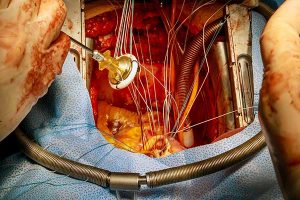What is the aortic valve?
There are four valves in your heart including the mitral, tricuspid, aortic and pulmonic valves. The aortic valve is located between the left ventricle (lower heart pumping chamber) and the aorta. The aorta is the largest artery in the body. Valves maintain one-way blood flow through the vascular system and the heart.
What is aortic valve disease?
Aortic valve disease happens when the aortic valve does not function correctly. This can be caused by:
- Aortic valve stenosis: is when valve leaflets have become stiff, fused, thickened, and inflexible leading to the narrowing of the aortic valve. This limits the blood flow. Aortic valve stenosis happens when calcium is deposited on the valve leaflets, further limiting their movement. Stenosis can occur in patients with either a tricuspid (3 leaflets) or a bicuspid (2 leaflets) aortic valve.
- Aortic valve regurgitation (also called valvular insufficiency, incompetence or “leaky valve”): These valve leaflets do not close completely. Regurgitation causes the blood that is ejected by the heart to immediately flow back into the heart once the heart stops squeezing and relaxes.
There are a lot of causes of valve regurgitation such as floppy leaflets (prolapse), infection of the valve (endocarditis), abnormal congenitally deformed valves (bicuspid or uni-cuspid), the inability of the leaflets to close tightly due to dilatation of the aorta (aneurysm), holes in the leaflets, or rheumatic valve disease.
What causes aortic valve disease?
The aortic valve may be abnormal at birth (typically a bicuspid congenital aortic valve) or become diseased over time, usually observed in older patients (acquired valve disease).
What are the symptoms of aortic valve disease?
Many patients with aortic valve disease are have no symptoms, even when the stenosis (narrowing) or insufficiency (leak) are severe.
 Initial symptoms of aortic valve disease usually include:
Initial symptoms of aortic valve disease usually include:
- Fatigue
- Easily tired
- Loss of energy
- Swelling at the ankles
- Palpitations (extra or skipped heart beats)
More advanced symptoms may include:
- Shortness of breath
- Chest pain
- Dizziness or loss of consciousness
Diagnosis
The diagnosis of aortic valve disease is made after your doctor reviews your symptoms, performs a physical exam, and listens for a murmur, and evaluates the results of your diagnostic tests.
The diagnosis of aortic valve disease is confirmed by a specialized heart ultrasound called an echocardiogram. The echocardiogram allows the doctor to visualize your heart valves and determine the severity and possible cause of the aortic valve disease.
Aortic Valve Surgery
There are two types of aortic valve surgery: aortic valve repair and aortic valve replacement.
During aortic valve surgery, including aorta surgery, the aortic valve may be repaired or replaced. The results of your diagnostic tests, the structure of your heart, your age, the presence of other medical conditions and other factors will be considered to determine whether aortic valve repair or replacement is the best treatment for you.
Aortic Valve Repair
While the aortic valve is usually replaced, aortic valve repair may be an option. Your surgeon will advice whether your valve can be repaired.
Aortic Valve Replacement
If valve repair is not an option, your surgeon may replace the valve. The new valve can either be mechanical or biological.
Biological valves (also called tissue or bioprosthetic valves) are made of tissue, but they may also have some artificial parts to provide additional support and allow the valve to be sewn in place. About 80% of aortic valves are replaced with a bioprosthesis.
Biological valves can be made from pig tissue (porcine), cow tissue pericardial (bovine), or pericardial tissue from other species.
These valves are safe to insert, durable (lasting from 15 to 20 years), and allow patients to avoid lifetime use of anticoagulants (blood thinning medications).
Mechanical valves are made completely of mechanical parts, which are non-reactive and tolerated well by the body. The bileaflet valve is used most often.
It consists of two pyrolite (qualities similar to a diamond) carbon leaflets in a ring covered with polyester knit fabric.
All patients with mechanical valve prostheses need to take an anticoagulant medication, warfarin (Coumadin), for the rest of their life to reduce the risk of blood clotting and stroke. This increases the risk of bleeding.
